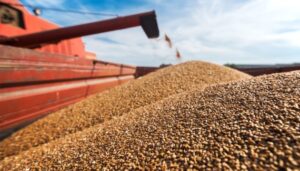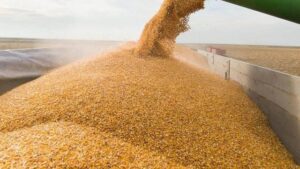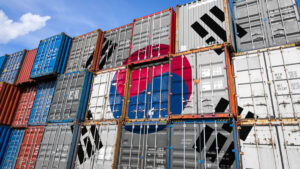
Ukraine exported 57.5 mln tonnes of grains and oilseeds in 2023-2024 marketing year, which ended on June 30, 2024, out of the harvest of 82.8 mln tonnes, while the carry-over stocks amounted to about 7 mln tonnes, the Ukrainian Grain Association (UGA) reported.
“Last season, the most important factor for the export of Ukrainian grain was the opening of the Ukrainian Humanitarian Corridor, which allowed exports by sea from the deep-water ports of Odesa region. The second most important factor was the introduction by Ukraine, together with international partners, of a working mechanism for insuring ships entering Ukrainian ports, which reduced the costs of exporters and, accordingly, Ukrainian agricultural producers for export logistics,” the association noted.
According to the UGA analysts, referring to the information of the State Customs Service, in monetary terms, the exports of grains and oilseeds in 2023/2024 MY amounted to $10.76 bln, and exports including products from them, including sunflower oil and other oils, cake and meal – $17.86 bln.
Wheat exports amounted to 18.4 million tons worth $3 billion, with production of about 22 million tons. The top 3 importing countries of Ukrainian wheat were Spain, which purchased 5.899 mln tons, Egypt – 1.721 mln tons, and Indonesia – 1.515 mln tons.
Ukraine exported almost 2.5 mln tons of barley for $376 mln, against the production of 5.8 mln tons. The most active buyers were China – 702 thousand tons, Indonesia – 460 thousand tons, and Cyprus – 221 thousand tons.
Last season, Ukraine exported 29.3 mln tons of corn worth $4.7 bln, compared to last year’s production of 29.6 mln tons. Its main buyers were Spain – 6.011 million tons, China – 4.832 million tons, and Egypt – 3.874 million tons.
Almost 3 mln tons of soybeans were sold to other countries for $1.1 bln, with a harvest of 4.9 mln tons. The top 3 buyers were Egypt – 956 thsd tonnes, Turkey – 674 thsd tonnes, and Germany – 235 thsd tonnes.
Ukraine exported 3.7 mln tons of rapeseed worth $1.4 bln, compared to last year’s production of 4.5 mln tons. The most active buyers were Germany – 1.226 mln tons, Romania – 609 thsd tonnes, and the Netherlands – 420 thsd tonnes.

In January-June 2024, Ukraine exported $10.97 billion worth of goods to the European Union, which is 9.7% less than in the first half of 2023, Deputy Minister of Economy and Trade Representative of Ukraine Taras Kachka said.
“This is an obvious correlation of transportation routes. Exports to the EU decreased the most to neighboring countries – to Poland by 25.7%, to Slovakia by 21.3%, to Hungary by 67.2%, and to Romania by 50.2%. On the other hand, exports to Spain (81.1%), Italy (24.7%), and the Netherlands (22.4%) increased significantly,” he wrote on Facebook.
Kachka pointed out that this correlation makes it possible to clearly see trade with the EU without forced transit to third countries.
“This will allow us to resolve a lot of problems that have accumulated in relations with neighboring countries,” he suggested.
The Ukrainian trade representative emphasized that the existing problems show that in 2022-2024 Ukraine has significantly narrowed the range of “sensitive” goods in trade. Before the war, these included steel, which was subject to trade protection, and 36 categories of agricultural products that were subject to temporary liberalization, or quotas.
He reminded that under the current phase of autonomous trade measures, the number of such sensitive products has been reduced to seven: poultry, eggs, sugar, honey, corn, oats, and cereals.
Commenting on the European Commission’s quotas on Ukrainian sugar and eggs, Kachka noted that active exports from Ukraine have reached certain thresholds.
“If the sugar trade with the EU is suspended to normalize trade in accordance with the decision of the Ukrainian side, the export of eggs will continue. We expect that the general EU quota within the WTO will apply to Ukrainian products and a reduced duty of EUR15.2 per 100 kg (quota 09.0154) will be applied,” he wrote, adding that all these nuances have been discussed with both the EU and the market.
The Ukrainian trade representative emphasized that Ukraine’s common goal is to resolve all sensitive issues with the EU and define clear parameters of trade under the Association Agreement by June 5, 2025.

In January-June 2024, Ukraine exported $10.97 billion worth of goods to the European Union, which is 9.7% less than in the first half of 2023, Deputy Minister of Economy and Trade Representative of Ukraine Taras Kachka said.
“This is an obvious correlation of transportation routes. Exports to the EU decreased the most to neighboring countries – to Poland by 25.7%, to Slovakia by 21.3%, to Hungary by 67.2%, and to Romania by 50.2%. On the other hand, exports to Spain (81.1%), Italy (24.7%), and the Netherlands (22.4%) increased significantly,” he wrote on Facebook.
Kachka pointed out that this correlation makes it possible to clearly see trade with the EU without forced transit to third countries.
“This will allow us to resolve a lot of problems that have accumulated in relations with neighboring countries,” he suggested.
The Ukrainian trade representative emphasized that the existing problems show that in 2022-2024 Ukraine has significantly narrowed the range of “sensitive” goods in trade. Before the war, these included steel, which was subject to trade protection, and 36 categories of agricultural products that were subject to temporary liberalization, or quotas.
He reminded that under the current phase of autonomous trade measures, the number of such sensitive products has been reduced to seven: poultry, eggs, sugar, honey, corn, oats, and cereals.
Commenting on the European Commission’s quotas on Ukrainian sugar and eggs, Kachka noted that active exports from Ukraine have reached certain thresholds.
“If the sugar trade with the EU is suspended to normalize trade in accordance with the decision of the Ukrainian side, the export of eggs will continue. We expect that the general EU quota within the WTO will apply to Ukrainian products and a reduced duty of EUR15.2 per 100 kg (quota 09.0154) will be applied,” he wrote, adding that all these nuances have been discussed with both the EU and the market.
The Ukrainian trade representative emphasized that Ukraine’s common goal is to resolve all sensitive issues with the EU and define clear parameters of trade under the Association Agreement by June 5, 2025.

Ukraine’s international trade in goods remained stable in January-June 2024 compared to the same period in 2023: $19.5 billion worth of goods were exported, which is the same as last year, Deputy Minister of Economy and Trade Representative of Ukraine Taras Kachka said on his Facebook page.
According to him, the physical export capacity increased by 35% to 71 million tons.
“Over the year, there was a significant correlation in prices for the main export commodities, which explains the phenomenon when the volume of exports in weight is much higher, while the revenue remains stable,” Kachka explained.
The trade representative pointed out that the increase in the capacity of trade routes has an interesting impact on the pace of exports by month.
After record-breaking April and May, exports in June amounted to $2.7 billion and 9.7 million tons, respectively, which is a significant drop compared to May, Kachka said, adding that this is 18.4% less in monetary terms and 20.2% less in volume.
The main reason for this decline in exports, according to the Ukrainian trade representative, is the completion of last year’s harvest. Corn was exported by 23.7% less in June, wheat by 40.8% less, and oil by 37.8%.
At the same time, the top 10 exports remained stable: ore – 239 million (-1.5% compared to May), poultry – 79 million (-3.5% compared to May), flat products – 79 million (+7%), soybeans – 66 million (+45%).
According to Mr. Kachka, imports in June were also down 5.6% to $4.8 billion.
At the same time, in the first half of 2024, Ukraine imported goods worth $31.9 billion, which is 4.9% more than in the first half of last year.
He reminded that a new marketing year for grains and oilseeds began on July 1, and offered to summarize the results of MY 2023-2024.
According to Mr. Kachka, Ukraine exported 69.86 mln tons of grains, oilseeds and oils.
“The export of wheat amounted to 18.43 mln tonnes, which is 9% more than in 2022/23 MY. Corn exports amounted to 29.41 mln tonnes, up 0.2% compared to the previous marketing year. Barley – 2.48 mln tons, down 8.5%. Soybeans – 2.98 million tons, also -8.2% compared to last year. Rapeseed – 3.7 million tons, up 8.7%. Sunflower oil – 6.54 million tons, up 22.8%. Soybean meal – 0.662 million tons, +12.5%, sunflower meal – 5.15 million tons, +29.1%,” he said.
Kachka also drew attention to the “staggering drop in exports, which is good news”.
“Last marketing year, Ukraine exported only 324 thsd tonnes of sunflower. This is 86.3%. That is, we are returning to a situation where sunflower is processed in Ukraine,” summarized the Ukrainian trade representative.

Since August 2023, the sea corridor created by the Ukrainian Navy has exported 55 million tons of cargo, of which more than half (37.4 million tons) were agricultural products, the Ministry of Communities, Territories and Infrastructure (MinRestore) reports.
“During the 10 months of operation of the Ukrainian Sea Corridor, a record amount of cargo was transported – 55 million tons of cargo – the cargo turnover of the ports of Greater Odesa,” the report says.
The Black Sea ports handled 1,954 thousand vessels.
Approaching the ports of Odesa, Chornomorsk and Pivdennyi are 68 vessels, exporting almost 2 million tons of cargo, the Ministry of Reconstruction said.
In early June of this year, it was reported that the sea corridor had exported 50 million tons of cargo since its launch, with 1737 vessels handled in the ports.

Kormotech, Ukraine’s largest producer of cat and dog food, has started exporting its products to the Korean market, the company’s press service told Interfax-Ukraine.
As specified in the report, since June 17, Kormotech’s Optimeal and Club 4 Paws brands have been presented on 12 Korean specialized Internet sites.
South Korea’s pet food market ranks third among East Asian countries, after China and Japan in East Asia. In terms of money, it is three times larger than the Ukrainian market. The share of sales of specialized food for cats and dogs is 50% to 50%.
“The South Korean market is unique in that 67% of petfood sales are made through online channels. This is the highest figure in the world, according to Euromonitor reports. Therefore, one of the challenges in cooperation with South Korea is to gain experience in building and developing online sales in the premium and super premium market,” said Eduard Babenko, Head of Strategic Business Unit Ukraine, Moldova and Southeast Asia at Kormotech.
Kormotech started negotiations with a distributor, Korean company Careside co. Ltd last year, and a cooperation agreement was signed in the fall. At the end of May 2024, the distributor received the first two containers of dry and wet food Optimeal and Club 4 Paws, which is about 24 tons of products.
You Young Kook, CEO of the Korean company Careside co. Ltd. expects that experience in international markets and resources will help the Ukrainian manufacturer to succeed in the South Korean market.
“Kormotech pet food contains high quality ingredients and undergoes rigorous quality control. This is a significant advantage, especially for demanding Korean pet owners. It is impressive to see how the company is constantly deepening its expertise in understanding the approaches to pet food formulation and their impact on the health and quality of life of pets. And most importantly, the efforts it makes to develop a culture of care and companionship with pets,” said You Young Kook.
According to Vladyslav Mazurkevych, Kormotech’s Asia Export Market Development Manager, super premium and premium cat and dog food lines are already available on the following 12 e-commerce sites in South Korea: Naver, Coupang, TM, WM, G-market, Auction, 11th St., Lotte On, Interpark, SSG, CJ on style, GS Shop.
“By the end of this year, we want to start cooperation with pet stores and veterinary clinics so that customers can look at the product, inspect it, and feel it,” Mazurkevych explained.
In 2023, Kormotech’s turnover increased by 22.5% to $152 million from $124 million in 2022. The ratio of sales abroad and in Ukraine in tons is now 31% to 69%, respectively (in 2022, it was 28% abroad and 72% in Ukraine).